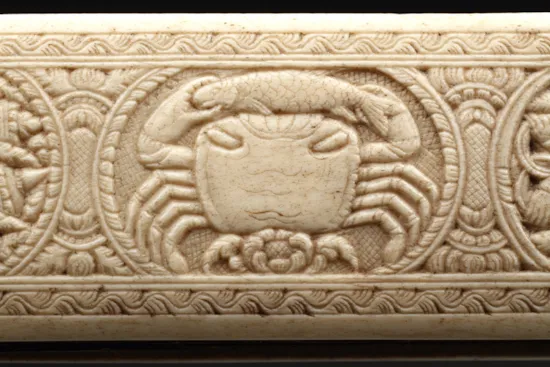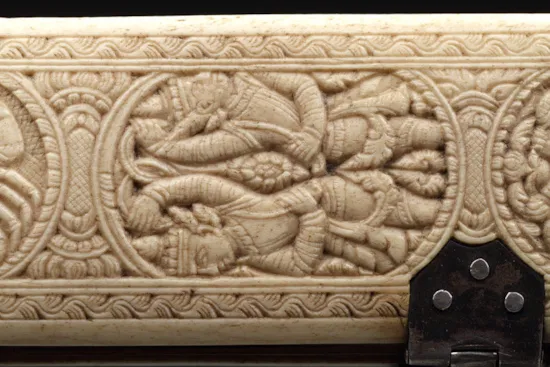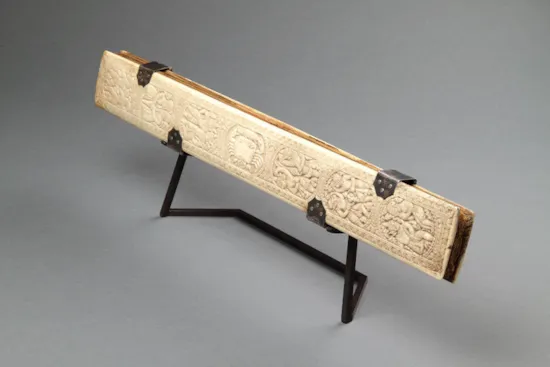Burmese Buddhist Palm Leaf Manuscript Ritual Text Bound in Two Finely Carved Bone Book Covers
A Burmese Buddhist Palm Leaf Manuscript Ritual Text Bound in Two Finely Carved Bone Book Covers
Decorated with Dancing Figures a Crab with a Fish and Buddha as a Lion Enclosed by Silver Clasps the Text Incised with a Stylus
Late 18th – Early 19th Century
Size: 6cm high, 50cm wide, 3cm deep - 2¼ ins high, 19¾ ins wide, 1¼ ins deep
Decorated with Dancing Figures a Crab with a Fish and Buddha as a Lion Enclosed by Silver Clasps the Text Incised with a Stylus
Late 18th – Early 19th Century
Size: 6cm high, 50cm wide, 3cm deep - 2¼ ins high, 19¾ ins wide, 1¼ ins deep
Buddhism is more pervasive in Burma than in any other country with gleaming whitewashed or gilded temples everywhere. Almost every village supports a monastery and early every morning saffron robed monks make their rounds to receive food from the people. To most Burmese, national identity is inseparable from their faith.
Sometimes called ‘Kammavaca’ these ritual texts represent a continuity of ceremonies from the earliest times, and are read aloud at monastic assemblies. The most important text is concerned with higher ordination, others with the bestowing of robes, electing elders, the dedication of monasteries and the release from monastic vows. They are a selection of rules prescribed for monastic ritual and discipline.
Burmese palm ‘ola’ leaf manuscripts are protected by cover-boards usually of lacquered wood rather than of bone. The number of leaves varies, as does the number of lines of script, either etched or painted on each leaf. The leaves are pierced for a string which holds the bundle together permitting each leaf to be turned. The manuscripts were often commissioned by donors for presentation to monasteries and it is only Burma that has continued the tradition of producing these ornate and decorative ritual texts.
Sometimes called ‘Kammavaca’ these ritual texts represent a continuity of ceremonies from the earliest times, and are read aloud at monastic assemblies. The most important text is concerned with higher ordination, others with the bestowing of robes, electing elders, the dedication of monasteries and the release from monastic vows. They are a selection of rules prescribed for monastic ritual and discipline.
Burmese palm ‘ola’ leaf manuscripts are protected by cover-boards usually of lacquered wood rather than of bone. The number of leaves varies, as does the number of lines of script, either etched or painted on each leaf. The leaves are pierced for a string which holds the bundle together permitting each leaf to be turned. The manuscripts were often commissioned by donors for presentation to monasteries and it is only Burma that has continued the tradition of producing these ornate and decorative ritual texts.
Burmese Buddhist Palm Leaf Manuscript Ritual Text Bound in Two Finely Carved Bone Book Covers

SOLD








































